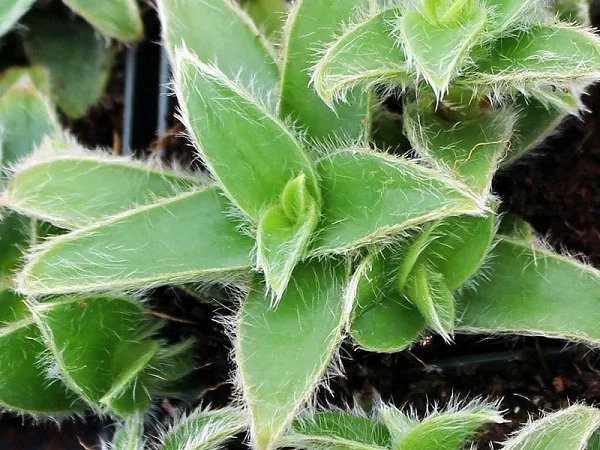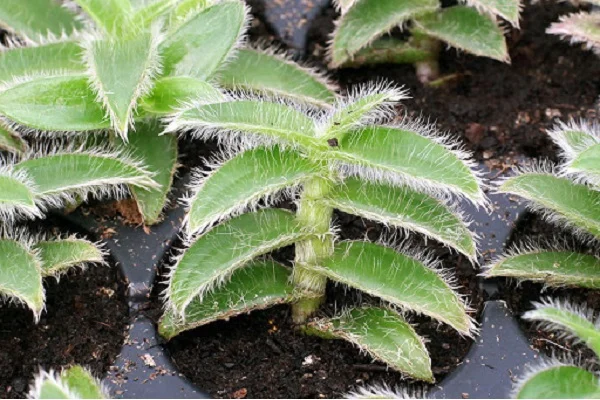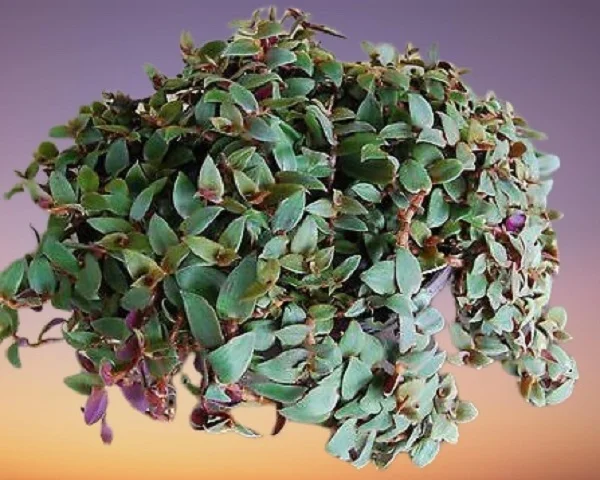Pussy Ears Vine (Cyanotis somaliensis) Care Indoors and Common Problems
Some links in this post may be affiliate links
Pussy Ears Vine (Cyanotis somaliensis) flourishes in bright indirect light, moderate warmth and humidity and moderately moist, rich, well-drained, succulents soils coupled with monthly feeding in spring and summer.
Cyanotis somaliensis also called Pussy Ears Plant or Kitten Ears Vine is a creeping succulent vine which bears oval-shaped leaves about 2 inches long which are covered with pale gray hairs.
Pussy Ears Plant is ideal for a hanging basket, pedestal or a tall pot where the trailing stems can beautifully cascade downwards. It is one of the beautiful hanging succulents for indoors.

Botanical name: Cyanotis somaliensis
Family: Commelinaceae
Common names: Pussy Ears Vine, Pussy Ears Plant, Kitten Ears Vine
Origin
Cyanotis somaliensis is native to northern Somalia and is closely related to Cyanotis kewensis (Teddy Bear Vine) which is native to South Africa. They are both popular plants for indoor hanging baskets.
Is Cyanotis somaliensis toxic?
There are no reported cases of Cyanotis somaliensis toxicity to humans, cats, dogs or other pets. Therefore, it is better to err on the side of caution. Keep the plants out of the reach of children and pets.
Where to Buy
If you would like to acquire Kitten Ears Vine, you may obtain them online from Etsy (Link to Etsy).
How to Care for Cyanotis somaliensis Indoors
To care for Cyanotis somaliensis indoors, give it bright indirect light (filtered light), warmth of 18-280C, humidity of 50-55% and moderately moist, rich, succulents soils coupled with monthly feeding in spring and summer.
Pussy Ears Vine care also requires repotting only when it becomes pot-bound. Pruning is necessary to control and rejuvenate growth. Keep reading for more on these growing conditions and how to achieve them.

Watering
Water Cyanotis somaliensis liberally in spring and summer and allow the top 2-3 inches of soil to dry out between waterings. Maintain the soil moderately moist and avoid overwatering to prevent rotting, yellowing and leaf loss.
Reduce watering in fall and winter as growth is minimal at this time to keep the soil slightly moist. Never allow the soil to dry out completely to prevent wilting, yellowing and leaf drop.
Use water that is at the room temperature to avoid cold shock which can result in reduced growth and leaf loss. Ensure that the water is chlorine-free to prevent staining and browning of the leaves.
Ascertain that the pot has a drainage hole to prevent the soil from getting soggy soil as it can lead to rotting. Avoid wetting the foliage; you may water from the bottom to discourage fungal diseases.
Light Requirements
Pussy Ears Vine grows best in bright indirect light. Keep it away from direct sunshine to prevent scorching of the leaves.
If the light is not adequate the growth may slow down, the plant will become weak and leggy with wide spaces between the leaf nodes and pale leaves. You may use a grow light if the natural lighting is not adequate.
Rotate the pot regularly to ensure that the Kitten Ears Vine receives light on all sides for uniform growth.
Temperature & Humidity
Cyanotis somaliensis thrives in a warmth of 18-280C to thrive. Keep it away from sources ofdrafts as can cause stunted growth and leaf drop.
Pussy Ears Plant has no need for high humidity; a humidity of 50-55% is adequate for this plant. However, if the indoor temperatures are too high resulting in too little humidity, set the pot on a wet pebble tray to increase humidity.
Potting Mix
Cyanotis somaliensis grows best in loose and free-draining soil that is rich in organic matter. The soil should be loose enough to allow water to drain out fast enough to avoid soggy soil which can cause rotting.Most Cactus and succulents mixes are ideal they drain easily and do not hold excess moisture.
Fertilizer
Feed Pussy Ears Vine with a balanced, water-soluble fertilizer every 4 weeks in spring and summer for a lush growth.
Do not feed in fall and winter as growth is reduced at this time thus feeding may cause fertilizer burn and death of the plant.
Regularly, flush out excess salts by running a stream of water through the soil until it drains through the drainage hole. Allow the water to run for about 5-10 minutes.
Pruning
Pussy Ears Vine pruning is easy. To encourage a compact, bushy growth and to prevent the vine from becoming straggly, regularly pinch off the growing tips. However, the stems become straggly with age, therefore cutback the stems to rejuvenate new growth.
Repotting
Repot Pussy Ears Vine at the beginning of growing season when pot-bound. Use a pot one size larger than the current one. Ensure that the pot has a drainage hole to prevent waterlogging as it can lead to rotting and eventual death of the plant. Check out these Ceramic Pots with Drainage Holes on Amazon.
Cyanotis somaliensis Propagation
Pussy Ears Vine (Cyanotis somaliensis) is propagated at the beginning of the growing season by plant division or from stem cuttings.
Learn how to propagate Pussy Ears Vine (Cyanotis somaliensis).

Cyanotis somaliensis Problems & Remedies
Pussy Ears Vine problems are brown leaves, yellow leaves, leggy growth, pests and diseases among others. Keep reading for more on these problems and their solutions.
Brown leaves
The main causes of brown leaves on your Cyanotis somaliensis are underwatering, extreme temperatures, and fertilizer burn.
How to fix it
Underwatering: Do not water on a schedule. Water when the top 2-3 inches of soil feels dry to touch.
Extreme temperatures: Keep the plant away from sources of drafts like windy doors, heat sources, AC units, hot air vents among others.
Salts buildup: Avoid too much fertilizer and do not feed in fall and winter. Flush out excess chemicals from the soil.
Yellow leaves
Some of the causes of yellow leaves on your Cyanotis somaliensis are too little light, soggy soil, inconsistent watering, drafts, nutrients deficiency or aging.
How to fix it
Too little light: Position the plant in bright indirect light or use a grow light if you do not have enough light in your home.
Soggy soil: Use fast-draining soil and a pot with a drainage hole.
Inconsistent watering: Water when the top 2-3 inches of soil feel dry to the touch but do not allow the soil to dry out completely.
Drafts: Keep the plant away from sources of drafts like hot air vents, AC units, hot surfaces, windy doors among others.
Nutrients deficiency: Feed the plant every 4 weeks in spring and summer with a balanced, water-soluble fertilizer.
Aging: This is a natural process. As the lower leaves mature, they turn yellow, brown and eventually die.
Leggy growth
Leggy growth on Pussy Ears Vine is caused by insufficient light, underwatering, nutrients deficiency or aging.
How to fix it
Cutback the stems to rejuvenate new growth and encourage a bushy, compact growth.
Insufficient light: Move the plant to a brighter spot where it will receive bright indirect light or use a grow light if the natural lighting is not adequate.
Underwatering: Water when the top 2-3 inches of soil to dry out but do not let the soil dry out completely.
Nutrients deficiency: Feed the vine with a balanced, water-soluble fertilizer every 4 weeks in spring and summer.
Aging: As the plant ages, naturally the stems become straggly.
Pests
Common pests on Pussy Ears Vine are aphids and spider mites which are common in dry, stuffy conditions.
How to fix it
- Isolate the affected the plant to prevent spread to the other plants.
- Treat the plant with neem oil or insecticidal soap as per the manufacturer's recommendations.
- Regularly check underneath and between the leaves for these pests and carry out timely control measures.
- Maintain the plant well pruned and elevate humidity to minimize the pest infestations.
Diseases
Cyanotis somaliensis is prone to powdery mildew and leaf spot disease which are prevalent in overwet conditions coupled with poor air circulation.
How to fix it
- Isolate the affected plant to minimize spread to the other plants.
- Treat the affected plant with neem oil as per the manufacturer's instructions.
- Maintain free air flow to discourage the diseases.
- Water from the bottom to avoid wetting the leaves.
- Always allow the soil to dry out between waterings.
- Use a pot with a drainage hole and fast-draining soil to prevent waterlogging.
You liked it? Share on social media.
Related Content
Amazon Associates Disclosure
Homeplantsguide.com is a participant in the Amazon Services LLC Associates Program, an affiliate advertising program designed to provide a means for sites to earn advertising fees by advertising and linking to amazon.com.




